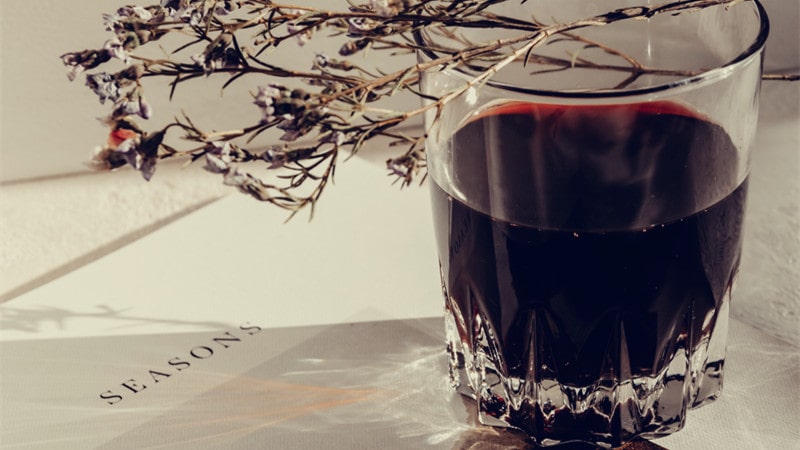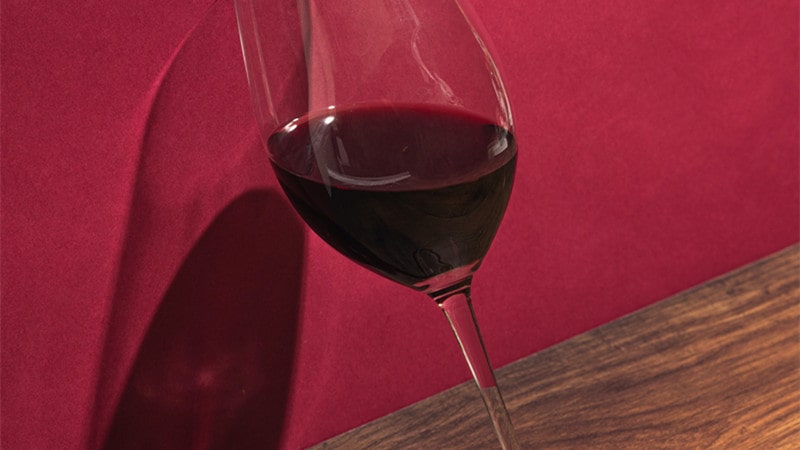Whether you’re looking to satisfy your cravings or want to cook up a storm in the kitchen, your taste buds will thank you for learning about wine.
So, get ready to go a bit deeper into the world of winemaking. You will discover what the driest red wine varieties are and how to pair them correctly with food for an explosion of flavors!
What Is Dry Red Wine?

Though you’d think that dry red wine is the type that feels dry on the tongue while sipping it, that’s not the context you want to look into. Technically speaking, wine dryness shows how long the fermentation lasted.
Some winemakers decide to rely on native yeast found on the grapes or in the cellar’s atmosphere to jumpstart fermentation. Others, however, simply add some yeast that will come alive in the solution and start converting sugar into alcohol, carbon dioxide, and heat.
If you want your wine to have a sweetness to it, you can end the fermentation process early to leave some sugar behind. However, winemakers eager to make dry wine let the fermentation process finish entirely — until the yeast has eaten away all the sugar.
Essentially, dry red wine is one that has no residual sugar and isn’t sweet. While drinking it, you will still taste the fruit, but it simply won’t be as sweet as, say, fruit juice.
Dry Wine Qualities

The lack of sugar and sweetness are the two major factors that can make a wine dry. Contrary to popular belief, dry wines don’t always leave your mouth dry or have higher alcohol content.
If a wine dries out your mouth, that just shows that it is high in tannins. You can experience the same sensation when drinking other beverages, such as black tea. Tannins naturally occur in black tea, so it’s common for it to taste a bit bitter and dry out the mouth.
Additionally, though red wines, in general, are usually more alcoholic than white wines because tannins can support a higher alcohol content, the relationship between alcohol and dryness is very open. Many sweet dessert wines have a high alcohol content, so checking a wine’s ABV (alcohol by volume) is not the best way to determine if a wine is dry.
The Driest Red Wines in the World
1. Bordeaux-Style Wines

Image source: Pinterest
The taste of Bordeaux-style wines is easy to remember as it’s a mix of hearty flavors of tobacco, dark cherries, and stone fruits. They are also tannic wines, which refers to their dryness and bitterness.
As the name implies, the grape varieties for these wine styles originated in France. However, they are also commonly grown in South Africa, Tuscany, and California.
Famous Bordeaux-Style Grape Varieties
• Cabernet Sauvignon creates a very popular, complex dry red wine. It’s a full-bodied wine that offers a bold mix of flavors, most notably black cherry, black currants, and olives.
• Merlot is used to make a dry red wine in two different styles. The traditional medium-bodied Merlot features red fruity flavors and is produced using early harvested grapes in order to keep it more acidic. The full-bodied New World variant, on the other hand, is made with more ripe grapes and tastes of blackberries.
• Cabernet Franc is a type of grape that’s typically blended with Merlot or Cabernet Sauvignon. On their own, medium-bodied Cab Franc wines have a complex flavor — a mix of herbs, red fruits, and peppery earthiness.
• Malbec is a grape variety whose origin can be traced to France but is now actually incredibly popular in Argentina. Malbec wines are deep purple-red, acidic, and full-bodied with fruity and spicy flavors.
• Petit Verdot is a grape variety mostly used in red Bordeaux-style blends. Wines made with these grapes are tannic and rich, both in body and color. The wines usually have violet notes, some spiciness to them (think pepper and sage), and noticeable fruity flavors (blueberry, blackberry, etc.).
• Carménère is a sun-loving type of grape that used to be a staple in France but has since reappeared in Chile. The wine flavor is mostly spicy and herbal, with some wonderfully intertwined fruity notes. When left to age in oak, it can develop dark chocolate and coffee notes, too.
2. Rhône-Style Wines

Image source: Pinterest
The Rhône-style wines have a curious aroma variety, consisting of favorites like stone fruits and cherries and a few surprises, such as nutmeg. The grapes that go into these wines, like Grenache and Syrah, are typical for the French Rhône region, though they’re also grown in Spain, Australia, and California.
Quintessential Rhône-Style Grape Varieties
• Grenache is a rather popular type of grape in Spain and Australia that’s often blended with the other three varieties. It’s a dark-skinned red wine grape used to make dry, semi-sweet, and sweet wines. The wines usually have both fruity and spicy notes, with some hints of other curious flavors, like tobacco, licorice, and dried herbs.
• Syrah (or Shiraz) can lend its qualities to various wines, depending on where the grapes are harvested. Though Syrah and Shiraz are the same grape, they may express themselves differently in cooler and warmer regions. Syrah wines from the cooler regions have a more acid-driven, savory taste consisting of a vast range of flavors (floral violet notes, smoke, herbs, pepper, etc.). In contrast, Shiraz wines from the warmer regions usually have jammy aromas with blueberry and blackberry flavors.
• Mourvèdre is a grape variety that originated in Spain and has intense black currant and blackberry flavors. Its wine is rich in tannins and medium acidic. The French also use it with other grape varieties, such as Grenache and Syrah, to create red blends.
• Cinsault is a French grape variety that comes from the Southern Rhône. It typically yields fruity and light wines and can also be blended with Grenache.
3. Burgundy-Style Wines: Pinot Noir

Image source: Pinterest
Unlike other types of wine, the Burgundy-style reds usually use only one grape variety — the Pinot Noir. The grape is a versatile one, no doubt, since you can use it to make both white and red wine. It’s also a translucent, light red type of grape with a delicate, disease-prone, and rather selective growing nature.
The taste of Pinot Noir wines varies greatly depending on how and where you grow the grapes. In France, the wines may have an earthier aroma with prominent notes of mushroom and forest floor. In contrast, those made in California may have notes of vanilla and clove alongside the unmissable black cherries.
Generally, though, Pinot Noir wines may taste like strawberries, blackberries, cherries, and raspberries. Apart from the mushroom notes, there may be some leather elements too.
The spiciness of this dry wine is also evident. Alongside cloves, you may notice some tobacco and cinnamon flavors, as well.
These three wine styles are popular around the world and favorites of many wine aficionados. However, there are other notable varieties you can try out too, such as:
• Tempranillo
• Nebbiolo
• Gamay
• Zinfandel
• Barbera
• Petite Sirah
• Sangiovese
Tips for Choosing Dry Red Wine

The path to choosing a good bottle of wine, especially a dry red, can seem a bit challenging at first. Here are three crucial tips to keep in mind when you find yourself unable to decide.
1. Prefer White Wines? Make the Switch With Light-Bodied Reds
There are some classic stereotypes surrounding wines. For example, people often say that white wine is usually more refreshing and light, whereas red wine is savory and complex.
The high tannin content usually discourages white wine drinkers from even trying a good dry red. But there are many dry red wines that could actually help you make the switch into a more crimson territory.
One of the best examples is Pinot Noir, which has a low tannin content. This fact alone makes it a bit lighter than some more complex options (like Cabernet Sauvignon) and thus a bit more refreshing.
2. Think About Your Preferred Flavors
Your taste preferences can tell you a lot about your favorite wines. If, for instance, you love sweets, you may not like dry reds at all and would prefer going for sweeter options, like port.
Strangely enough, the way you take your coffee may point you in the right direction here. Do you prefer your coffee dark and bitter? You may be the right candidate for Old World dry red wines, i.e., those that originated in France, Spain, or Italy.
However, if latte is your pick-me-up in the morning, you may want to go for less acidic, fruitier wines, like the New World ones, which come from the US, Australia, or South Africa.
3. Always Consider the Dish
Yes, white wine is usually a must with lighter dishes based on fish and chicken, whereas red wine goes better with heartier meals.
Nevertheless, some of the driest red wines out there can actually go perfectly with both types, allowing you to continue drinking reds throughout lunches and dinners.
Some of the best combinations include:
• Cabernet Sauvignon with beef, lamb, and smoked meats
• Malbec with brisket, pulled pork, and barbecue
• Syrah/Shiraz with spicier food, like Indian or Thai
• Pinot Noir with earthy ingredients, such as mushrooms and truffles, and it can also work well with some types of fish, like barbecue-glazed salmon
Cooking with wine also requires you to consider the quality. You shouldn’t use the wines sold as “cooking wines,” but instead go for a bottle you wouldn’t mind drinking on its own.
In general, you cannot go wrong with Merlot. It’s incredible both when cooking pan sauces and marinades and when used in steak, lamb, and short rib dishes. Pinot Noir, however, is perhaps even more versatile. It goes well with fattier stews and meats, poultry, and even seafood dishes.
As a rule of thumb, prepare hearty dishes with moderately tannic wines and lighter dishes using wines with low tannin content. If you pair a rather tannic wine with weak ingredients, your food may turn out bitter or chalky. Although some may enjoy the bitterness of dry red wine, the flavor can become quite intense and, for some, even unpleasant in a cooked meal.



